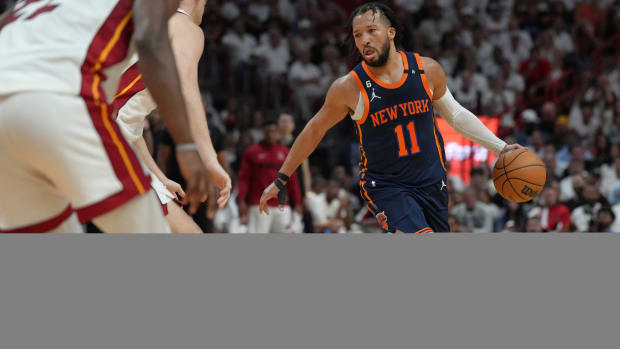Down two points with 25 seconds remaining in Game 6—and the Knicks’ season on the line—floor general Jalen Brunson dribbled down the right side of the floor.
Brunson already had a game-high 39 points, but was in search of two more to knot the contest to keep New York alive for a Game 7 and a shot at the conference finals. As Brunson got past Jimmy Butler, fellow Heat defender Max Strus stepped up, forcing the 6 ‘1” Brunson to try to maneuver through a trap involving both stoppers. By the time he picked up his dribble near the right block, all five Miami defenders—knowing they didn’t need to fear the Knicks’ shooters—had at least one foot in the paint, turning that area into an impenetrable fortress.
It resulted in Brunson throwing an ill-advised shovel pass to a cutting Julius Randle that got tipped and stolen by the swarming Heat defense. Game over. Series over. Season over.
The closing sequence was a microcosm for a number of things for New York, which, after making it this far with one of the younger rosters in the league, has an opportunity to take the next step in the East if it can manage to push the right transactional buttons this offseason.
The Knicks won an impressive 47 games during the regular season, earned the East’s No. 5 seed, and knocked out the immensely talented Cavs in the first round. New York’s campaign, off the heels of a 37-win season, was the result of solid rotation choices from coach Tom Thibodeau, internal growth from young players like Immanuel Quickley, Mitchell Robinson and Quentin Grimes and the magic of team president Leon Rose, who brought in Brunson as a free agent before nabbing wing Josh Hart via trade.
The question now, though, after 50 years without an NBA title, is what comes next. And this series loss to Butler and the Heat should give the Knicks plenty of answers from that standpoint.

Jim Rassol/USA TODAY Sports
New York thrives on the offensive glass, and beating less physical teams up inside. But the downside of that style is that the Knicks’ lack of spacing at times—particularly within an iso-heavy offense that doesn’t always produce enough movement—is undeniable, and asks too much of a small guard like Brunson. They clearly need more shooters, but not ones like ex-starter Evan Fournier, a 30-year-old who has range, but can’t defend well enough to log time on the court.
Likely the biggest issue of all, though, is Randle.
He battled with a difficult ankle injury, and then swelling around his right eye, throughout the playoffs, but ultimately shot just 37.4% from the field to go with 36 assists and 35 turnovers this postseason. This comes after his grisly playoff showing in 2021, when Randle shot 29.8% and finished with more turnovers (23) than assists against the Hawks in the first-round series.
Randle, the team’s lone All-NBA selection, has quick-twitch moments where he’s the best player on the floor, hitting jumpers, zooming passes and bowling over lesser, smaller defenders. But for all his success—he averaged 25 points and 10 rebounds in the regular season—those moments simply haven’t come often enough in a playoff setting. And between Brunson’s incredible ascension and consistency and the team’s need for more two-way depth, it’s certainly worth wondering if there’s a potential trade out there for the Knicks to move on from Randle.
Even if there ultimately isn’t, and Randle remains a Knick, Thibodeau should have learned a couple of things from this series. For starters: There’s never a reason—especially in a close-out game—to sit out both Brunson and Randle simultaneously, the way the coach did Friday.
The Knicks were up 36-30 early in the second period, but with both stars out—Thibodeau gave Brunson a breather starting at the 9:55 mark that quarter—New York fell behind, 37-36, in less than two minutes’ time. How disastrous were those two minutes? Of the Knicks’ four possessions with neither man on the floor, the club failed to even hit the rim on any of them.
Those sequences were as follows:
- A Hart turnover with a bad pass out of bounds.
- A Barrett turnover after he lost the ball.
- A Hart shot that got blocked at the rim by Bam Adebayo.
- A Barrett floater that turned out to be an airball.
Thibodeau then called timeout to plug Brunson back into the game. And the Knicks followed up by instantly scoring on their next three plays: A Barrett jumper, and two triples from Obi Toppin.
Among the other lessons: Don’t plug Hart and Barrett in playoff lineups together, as there isn’t enough space in the lane to operate with, given how defenses dare those two to shoot. (This was part of why Thibodeau’s starting lineups—inserting Hart for Quentin Grimes, even once Grimes was back healthy—were a challenge at times. It left the starting group with spacing problems, while also leaving the bench lineup without Hart’s transition and rebounding ability.)
New York can now move on from Derrick Rose, who, with a $15.6 million team option this coming season, would take up nearly 12% of the Knicks’ salary cap. The club will also shop for a space-saving deal for Fournier, who will be on an expiring deal for $19 million next season.
The bones for a deeper playoff run are intact with this club; perhaps even with Brunson as the lead option. It just seems clear that some of the other pieces—especially Randle, after a second rough postseason—need to be swapped out to make the Knicks’ offense more playoff ready.







